You're a professional, so you write thorough and secure validation for every one of your forms. You confirm values are in the proper shape and type, and when appropriate, even query the database with rules like exists. But what do we do when we aren't the owners of that information? Let's dig in.
Imagine you've made a deal with the fictional third-party payment provider called Spot to process payments for your users. They provide service in nearly all municipalities you operate in - except for a few. Each of those have custom rates and taxes for transactions. Luckily they provide an endpoint that returns this charge data or informs you that they don't operate there.
When users sign up on your service, all you ask for is a postal code. You have a database that maps these to more municipal areas for those third-party services that require more robust location information.
So, how do we validate that Spot provides service? Well, we certainly don't want to make two API calls (one in the form request to validate service, one in the controller to retrieve and use the rates), and storing results in a Form Request from this validation seems messy - almost like a single responsibility failure.
Most of the solutions I've seen end up requiring complex systems of sessions and additional Blade checks and components. Instead, I like to use the tools that Laravel already provides me. Plus, our users are now trained to see errors near the form fields anyway. Let's see how.
public function store(StoreRequest $request, SpotService $spotService)
{
$county = App\Models\County::wherePostCode($request->validated('post_code'))->sole();
$rates = $spotService->getRates($county->city, $county->state, $county->postCode);
if ($rates === null) {
throw Illuminate\Validation\ValidationException::withMessages([
'post_code' => 'We are unable to service this area at this time.',
]);
}
// do the rest of the process
}
Normally, Laravel uses the ValidationException to handle the failed rules in your form requests. The public static method withMesssages() is a nice helper method that creates an ad-hoc validator instance and populates your desired error in as a failure. Then Laravel takes over again and will take the user back to show them this third-party error in the same way as a local validation error. Pretty cool, huh?
Here to help,
Aaron
P.S. Validation... not the most exciting thing, but arguably one of the most important (in my opinion). We've written an easy to understand book about Laravel validation that goes beyond the docs to give you all you need - so there's no excuses now! :)

